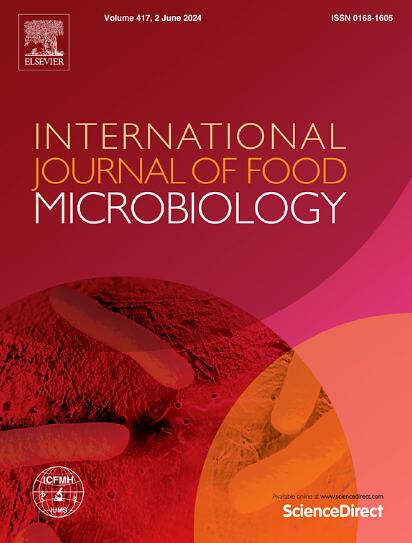Effect of co-inoculation of Pseudomonas fragi and Pseudomonas putida on the spoilage of chilled pork after the screening of a variety of different combinations of two Pseudomonas species
IF 5.2
1区 农林科学
Q1 FOOD SCIENCE & TECHNOLOGY
International journal of food microbiology
Pub Date : 2025-04-16
DOI:10.1016/j.ijfoodmicro.2025.111215
引用次数: 0
Abstract
This study preliminarily evaluated the effect of different combinations of two Pseudomonas species (P. fragi, P. lundensis, P. fluorescens, and P. putida) on the protein degradation capacity of meat and bacteria growth rules. Then P. fragi and P. putida, with the co-spoilage potential, were inoculated on pork to determine the ability of spoilage, and the potential spoilage genes further were revealed by whole genome sequencing. Results showed that, in the P. fragi + P. putida and P. fragi + P. fluorescens group, the diameter of Raw-pork Juice Agar (RJA) decomposition zone was significantly higher than that in the single-inoculated group, respectively. Furthermore, the results in situ showed that P. fragi and P. putida grew rapidly after co-culture, in which μmax was significantly higher than that in the single-inoculated group. In addition, at the end of storage, the pH and TVB-N values of pork after co-culture were significantly higher than those of the single-inoculated group, and the texture of pork was softer. Simultaneously, the contents of volatile organic compounds including 1-Octen-3-ol, 2-Nonanone, and Hexanal, were significantly increased after co-culture. Moreover, the genes of P. fragi and P. putida, identified by whole genome sequencing, related to amino acid metabolism, carbohydrate metabolism, and motor chemotaxis may be the primary reasons involved in the co-spoilage of pork. In conclusion, this study demonstrated that P. fragi and P. putida had a synergistic interaction to accelerate the spoilage of pork, which could provide a better understanding of co-spoilage of different Pseudomonas spp.
筛选两种假单胞菌的多种不同组合后,共同接种 fragi 假单胞菌和 putida 假单胞菌对冰鲜猪肉腐败的影响
本研究初步评价了两种假单胞菌(fragi P.、P. lundensis、P. fluorescens和P. putida)不同组合对肉类蛋白质降解能力和细菌生长规律的影响。然后接种具有共同腐败潜力的fragi P.和putida P.,测定其对猪肉的腐败能力,并通过全基因组测序进一步揭示潜在的腐败基因。结果表明,fragi P. + putida和fragi P. +荧光P.组的RJA分解带直径均显著高于单次接种组。原位结果表明,共培养后fragi P.和putida P.生长迅速,μmax显著高于单次接种组。此外,在贮藏结束时,共培养后猪肉的pH值和TVB-N值显著高于单次接种组,猪肉的质地更柔软。同时,共培养后挥发性有机物1-辛烯-3-醇、2-壬酮和己醛的含量显著增加。此外,通过全基因组测序鉴定出的与氨基酸代谢、碳水化合物代谢和运动趋化性相关的fragi P.和putida P.基因可能是导致猪肉共腐的主要原因。综上所述,本研究表明,fragi假单胞菌和putida假单胞菌具有协同作用,加速了猪肉的腐败,为更好地理解不同假单胞菌的共同腐败提供了依据。
本文章由计算机程序翻译,如有差异,请以英文原文为准。
求助全文
约1分钟内获得全文
求助全文
来源期刊
CiteScore
10.40
自引率
5.60%
发文量
322
审稿时长
65 days
期刊介绍:
The International Journal of Food Microbiology publishes papers dealing with all aspects of food microbiology. Articles must present information that is novel, has high impact and interest, and is of high scientific quality. They should provide scientific or technological advancement in the specific field of interest of the journal and enhance its strong international reputation. Preliminary or confirmatory results as well as contributions not strictly related to food microbiology will not be considered for publication.

 求助内容:
求助内容: 应助结果提醒方式:
应助结果提醒方式:


